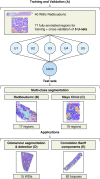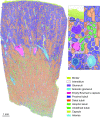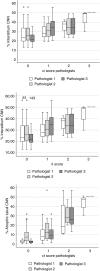Deep Learning-Based Histopathologic Assessment of Kidney Tissue
- PMID: 31488607
- PMCID: PMC6779356
- DOI: 10.1681/ASN.2019020144
Deep Learning-Based Histopathologic Assessment of Kidney Tissue
Abstract
Background: The development of deep neural networks is facilitating more advanced digital analysis of histopathologic images. We trained a convolutional neural network for multiclass segmentation of digitized kidney tissue sections stained with periodic acid-Schiff (PAS).
Methods: We trained the network using multiclass annotations from 40 whole-slide images of stained kidney transplant biopsies and applied it to four independent data sets. We assessed multiclass segmentation performance by calculating Dice coefficients for ten tissue classes on ten transplant biopsies from the Radboud University Medical Center in Nijmegen, The Netherlands, and on ten transplant biopsies from an external center for validation. We also fully segmented 15 nephrectomy samples and calculated the network's glomerular detection rates and compared network-based measures with visually scored histologic components (Banff classification) in 82 kidney transplant biopsies.
Results: The weighted mean Dice coefficients of all classes were 0.80 and 0.84 in ten kidney transplant biopsies from the Radboud center and the external center, respectively. The best segmented class was "glomeruli" in both data sets (Dice coefficients, 0.95 and 0.94, respectively), followed by "tubuli combined" and "interstitium." The network detected 92.7% of all glomeruli in nephrectomy samples, with 10.4% false positives. In whole transplant biopsies, the mean intraclass correlation coefficient for glomerular counting performed by pathologists versus the network was 0.94. We found significant correlations between visually scored histologic components and network-based measures.
Conclusions: This study presents the first convolutional neural network for multiclass segmentation of PAS-stained nephrectomy samples and transplant biopsies. Our network may have utility for quantitative studies involving kidney histopathology across centers and provide opportunities for deep learning applications in routine diagnostics.
Keywords: Banff classification; deep learning; histopathology; kidney transplantation.
Copyright © 2019 by the American Society of Nephrology.
Figures









Comment in
-
Machine Learning Comes to Nephrology.J Am Soc Nephrol. 2019 Oct;30(10):1780-1781. doi: 10.1681/ASN.2019070664. Epub 2019 Sep 5. J Am Soc Nephrol. 2019. PMID: 31488608 Free PMC article. No abstract available.
-
Artificial intelligence in nephropathology.Nat Rev Nephrol. 2020 Jan;16(1):4-6. doi: 10.1038/s41581-019-0220-x. Nat Rev Nephrol. 2020. PMID: 31597956 No abstract available.
References
-
- Racusen LC, Solez K, Colvin RB, Bonsib SM, Castro MC, Cavallo T, et al. .: The Banff 97 working classification of renal allograft pathology. Kidney Int 55: 713–723, 1999 - PubMed
-
- Servais A, Meas-Yedid V, Noël LH, Martinez F, Panterne C, Kreis H, et al. .: Interstitial fibrosis evolution on early sequential screening renal allograft biopsies using quantitative image analysis. Am J Transplant 11: 1456–1463, 2011 - PubMed
-
- Grimm PC, Nickerson P, Gough J, McKenna R, Stern E, Jeffery J, et al. .: Computerized image analysis of Sirius Red-stained renal allograft biopsies as a surrogate marker to predict long-term allograft function. J Am Soc Nephrol 14: 1662–1668, 2003 - PubMed
Publication types
MeSH terms
LinkOut - more resources
Full Text Sources
Medical

